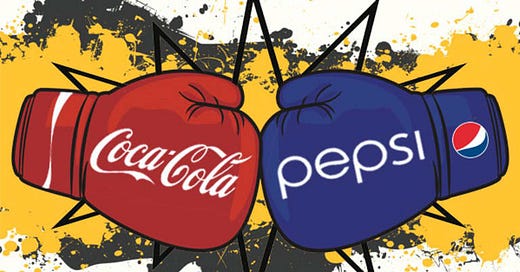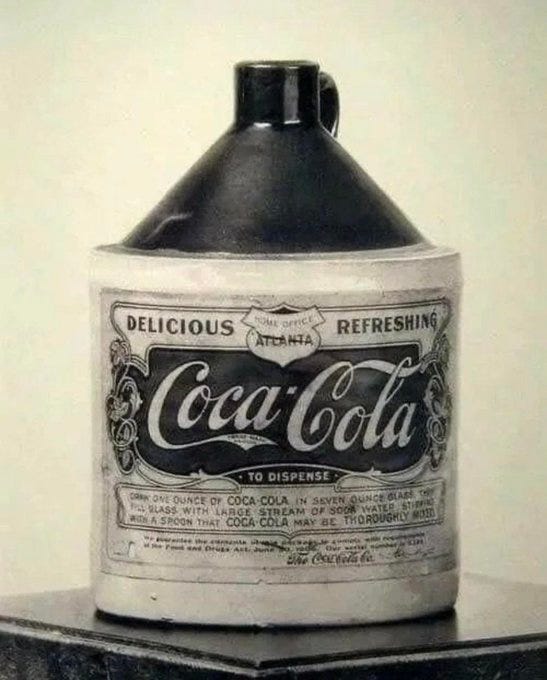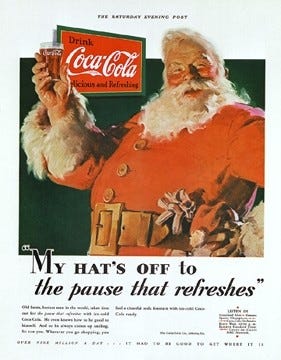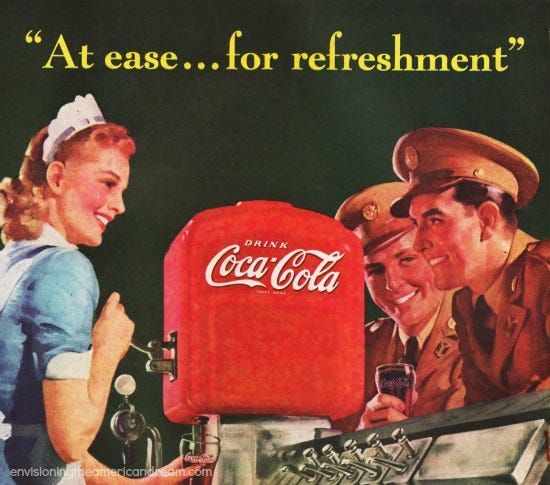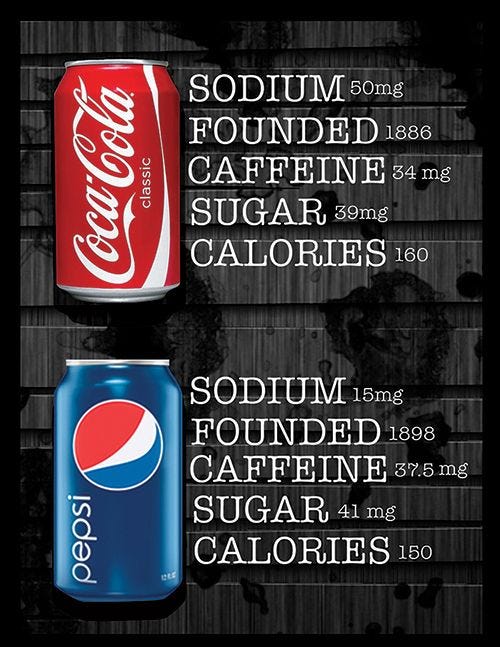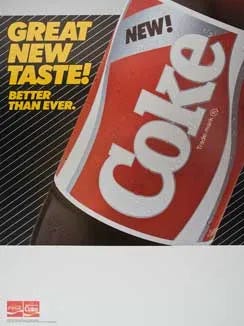The Cola Wars: Part 1
A deep dive into the greatest marketing rivalry in history and how it has shaped the world of advertising as we know it.
Earlier this year, Sony announced a $1 million offer for Cola Wars, a movie script that tells the true story of Pepsi and its attempts to usurp Coca-Cola as the king of soda. Pepsi’s series of innovative and increasingly aggressive marketing campaigns in the 1980s led to the escalation of what’s known as the ‘Cola Wars’. But this was just the latest salvo in a long history of rivalry between the giants. So how did this all begin?
It started with one simple question.
Coca-Cola or Pepsi? For over a century, loyal fans of each brand have been deep in the trenches fighting a bitter war to decide which type of carbonated sugar water is better.
Forget Drake vs Kendrick, forget Donald Trump vs Joe Biden and forget Kanye West vs himself, this is what real competition looks like. Just two global beverage conglomerates, with similar market caps and an almost identical flagship product, battling it out to see who can sell more cans of sugary liquid gold.
Today I am peeling back the layers of this great rivalry to understand how it started while looking at some of the highlights before ultimately questioning what the future may hold for both of these iconic brands.
The Early Years
Coca-Cola was created in 1886 by John S. Pemberton, a pharmacist in Atlanta, Georgia, who based the recipe on that of coca wine, a mix of cocaine and red wine that was used as an energy drink in 18th century Europe.
Seeing how much people loved cocaine-infused drinks, but also wanting to appeal to a broader market, Pemberton created Coca-Cola as a non-alcoholic version and it quickly became a popular soda fountain drink (they kept the cocaine in until 1903).
On the other hand, Pepsi, created by Caleb Bradham in New Bern, North Carolina in 1893, was first introduced as "Brad's Drink" and renamed Pepsi-Cola in 1898. It was first promoted as a digestive aid to treat dyspepsia (indigestion) which is where it got its name, a fact that you won’t find on Pepsi’s ‘about us’ page for some weird reason.
In the early years, Coca-Cola overshadowed Pepsi. With its aggressive marketing and distribution strategies, they became the dominant force in the soft drink market. They were so influential in fact that they invented the modern image of Santa Claus when, in 1931, they had illustrator Haddon Sundblom draw up Santa for a series of Christmas advertisements. These were so popular that the portrayal of Father Christmas as a portly man with a white bushy beard, rosy cheeks and a red winter coat has stuck around ever since.
It wasn't until the Great Depression that Pepsi began to gain ground, marketing itself as a budget-friendly option with the slogan "Twice as much for a nickel."
The Birth of the Cola Wars
The real heat in the competition began in the post-World War II era when Pepsi launched an aggressive marketing campaign featuring the slogan “for those who think young” which aimed to target the youth of the "Baby Boomer" generation.
This marked a significant shift in Pepsi’s strategy, positioning itself as a lifestyle drink for the young and trendy. The campaign, under the guidance of Pepsi’s president, Al Steele, and his wife, actress Joan Crawford, significantly boosted Pepsi’s image and market share.
Coca-Cola responded by trying to solidify its image as an iconic, patriotic American brand with advertisements depicting returning servicemen smiling and drinking the soda. Both companies would continue down these paths for the next couple decades with Pepsi promoting itself as a drink for the youth while Coca-Cola tried to position itself as an iconic American beverage for the everyday man or woman.
I’d like to buy the world a Coke
This would all change in 1971 when Coke began targeting the youth with the iconic “Hilltop” campaign featuring the famous jingle “I’d like to buy the world a Coke”. The idea came from Bill Backer, an advertising executive at McCann Erickson, who, while waiting for a delayed flight, noticed people smiling at the airport bar while sharing a Coke. I’ll let Backer explain the rest.
“So that was the basic idea: to see Coke not as it was originally designed to be — a liquid refresher — but as a tiny bit of commonality between all peoples, a universally liked formula that would help to keep them company for a few minutes.” - Bill Backer
The story goes that Backer quickly wrote down a few lines of the jingle on a napkin and the rest is history. The ad features a group of diverse young people singing the jingle on a hilltop in Italy all while holding a bottle of Coke. At a cost of $250,000, this was the most expensive ad ever produced at the time and represented a significant risk for Coke if it fell flat.
Luckily for them, the catchy tune would go on to achieve critical success resulting in over 100,000 people sending letters to Coke praising the ad and radio stations across the country being flooded with requests for the song. It was such a success that the original song even reached the no.7 spot on Billboard’s Hot 100.
The Pepsi Challenge
However, just a few years later in 1975, Pepsi would strike back hard with one of the most aggressive and influential marketing campaigns in history, The Pepsi Challenge.
The challenge was simple. Pepsi representatives travelled to shopping malls across the US where they would set up stalls and offer passing shoppers the opportunity to try both Pepsi and Coke in a blind taste test. They weren’t told which cola was which until after they had chosen their favourite and time and time again participants would choose Pepsi. The results were published far and wide and led to a significant increase in Pepsi sales across the country.
Now, before we look at Coke’s response, it’s important to understand the key difference between the two products, the sugar content. You see, a can of Pepsi has two more grams of sugar than a can of Coke which, while that doesn’t sound like much, does lead to a slightly sweeter taste.
It’s this sweeter taste that made The Pepsi Challenge so successful. You see, studies have shown that humans prefer a sweeter taste in smaller doses but prefer less sugar when drinking a larger amount of liquid. In essence, consumers would choose a sip of Pepsi over a sip of Coke almost every time but over the course of a full bottle they were more likely to choose Coke. Pepsi executives realised they could exploit this one sip preference and so they built an entire marketing campaign around this concept.
New Coke, New Problems
The success of The Pepsi Challenge scared the hell out of Coke. How could they sit idly by and let their biggest competitor outdo them through a simple taste test?
Well, as the old saying goes, “if you can’t beat em, join em” and join them they did when, in 1985, they made the radical decision to change their 100 year old recipe by making it slightly sweeter in a bid to make the product similar to Pepsi. This new version was known as “New Coke” and would replace the original recipe. That’s right, they didn’t just introduce a new version of their flagship product, they replaced it completely.
It would be an understatement to say this didn’t go down too well. You see, generations of loyal consumers had become accustomed to the classic taste of Coke and thus were subsequently outraged when the product they had grown to love was no longer available.
The overwhelming backlash forced Coke to backtrack after just 77 days when they brought back the original recipe under the guise of “Coca-Cola Classic”, a label that would last all the way until 2009 when they finally felt it was safe to revert back to the original name of “Coca-Cola”.
The Saga Will Continue…
Join me next Tuesday for The Cola Wars: Part 2 as we follow this great marketing rivalry throughout the 1980s and into the modern era. From the king of pop catching on fire to the rivalry reaching space to Kendall Jenner attempting to solve institutional racism with a can of Pepsi, the Cola Wars are only just getting started.

